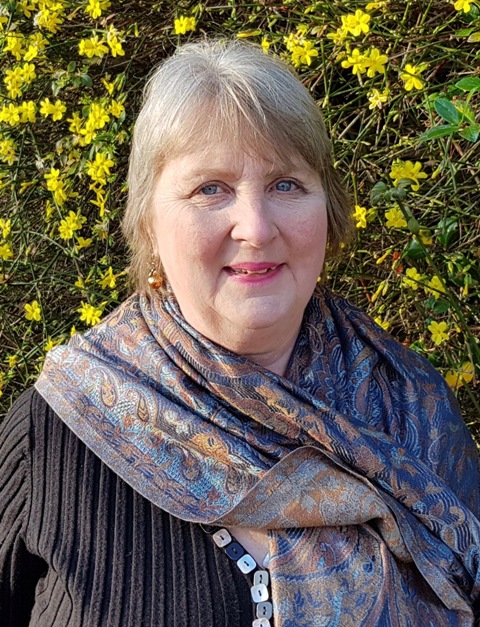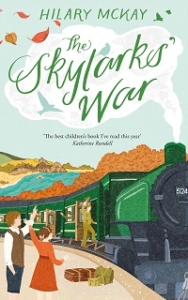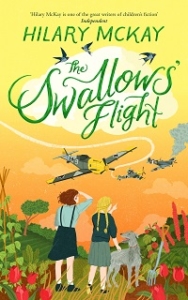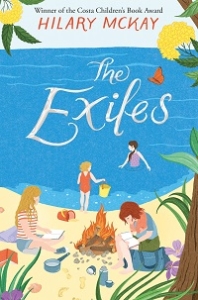
Up with the Skylarks
Hilary McKay is the author of more than thirty books for children, including the Exiles trilogy, the Casson Family series, and The Skylarks’ War and its sequel The Swallows’ Flight. Winner of the Guardian Children’s Fiction Prize, the Nestle Smarties Gold Award and the Costa Children’s Book Award, she is renowned for her deft characterisation, wry humour, eccentric families, and vivid depiction of the natural world. Imogen Russell Williams interviewed Hilary for this issue of Books for Keeps.
Many of your young protagonists engage deeply with books. What did you read yourself as a child that stayed with you and shaped your ways of thinking?
Enid Blyton got me to be a fluent reader. I read all through them, and then it seemed like I could read anything – and I did! We didn’t have many books at home, but we did have a constant supply from the library. I read Joan Aiken, [Gavin Maxwell’s] Ring of Bright Water, The Hobbit, all the Arthur Ransomes – I read across fantasy, a lot of natural history, Gerald Durrell and things like that. I liked history, too. I can’t think of much I didn’t read.
The power of place is strongly present in your work, especially places where your heroes spend joyous holidays, like the Cornish coast for the Skylarks and the Exiles. Did you have places like those when you were growing up?
No, I didn’t. We lived in Boston, Lincolnshire, which was a nice little town, I suppose, looking back on it, but we were bored stiff – the countryside was very flat and mechanised, 70s, 80s agriculture. We did have a beautiful salt marsh, and we used to go down there, but I didn’t really see countryside at all until I was thirteen or fourteen. We didn’t have a car; we were quite poor, and we didn’t go anywhere much. We’d go to the seaside, and my dad loved London, so we used to go to London. But I didn’t see hills and greenness until I was quite a lot older, and then I realised that what I’d been reading about was true.
 Your Costa-winning book The Skylarks’ War follows three love-starved children into the heartbreak of the First World War. The sequel, The Swallows’ Flight, follows two German boys and two English girls as the shadows of the Second World War descend…What drew you back into the Skylarks’ world?
Your Costa-winning book The Skylarks’ War follows three love-starved children into the heartbreak of the First World War. The sequel, The Swallows’ Flight, follows two German boys and two English girls as the shadows of the Second World War descend…What drew you back into the Skylarks’ world?
It was a financial decision. But also I liked the characters, and a lot of people said ‘What happened next?’ So the obvious thing to do was to move on to the Second World War. But I never intended to write a sequel. If I had, I wouldn’t have given the characters so many children. I ended up with 26 main characters and a dog! My editor Venetia Gosling drew me a huge family tree, and she told me the story of her granny on a farm in Kent, during the Second World War, the Battle of Britain. She was a very young girl, alone on the farm, and a dogfight was happening, and an airman came out of his plane, and Venetia’s granny ran to rescue him, and he survived. I used that story as the basis of The Swallows’ Flight.
What sort of research did you do?
 You know Emil and the Detectives [by Erich Kästner]? There’s a tour in Berlin where they take you round all those old streets, and I wanted to go, because I used that book for my German boys – I used their speech patterns to make it sound like my boys were speaking in a different language. I didn’t get to go, but I spent a lot of time in the British Library, so that after lockdown there were people there I could contact, and they were brilliant. They sent me street maps of old Berlin; they sent me three papers on the historic price of rubies, when I’d only asked one question! I didn’t get to the [Imperial War] museum at Duxford, where there’s a plane I wanted to see, to see how you climbed into the cockpit, but we did it from photographs, so that worked out. I found stuff on the internet – you can get old film of dogfights, or what a machine-gun sounds like in the sky. And I did get to the V&A before it closed – that was useful, for swimming costumes and what people were wearing. But then I made a big mistake. I usually dress people in the second draft – and I forgot to dress them! Still, nobody’s said anything about the fact they’re all naked. But I expect they will…
You know Emil and the Detectives [by Erich Kästner]? There’s a tour in Berlin where they take you round all those old streets, and I wanted to go, because I used that book for my German boys – I used their speech patterns to make it sound like my boys were speaking in a different language. I didn’t get to go, but I spent a lot of time in the British Library, so that after lockdown there were people there I could contact, and they were brilliant. They sent me street maps of old Berlin; they sent me three papers on the historic price of rubies, when I’d only asked one question! I didn’t get to the [Imperial War] museum at Duxford, where there’s a plane I wanted to see, to see how you climbed into the cockpit, but we did it from photographs, so that worked out. I found stuff on the internet – you can get old film of dogfights, or what a machine-gun sounds like in the sky. And I did get to the V&A before it closed – that was useful, for swimming costumes and what people were wearing. But then I made a big mistake. I usually dress people in the second draft – and I forgot to dress them! Still, nobody’s said anything about the fact they’re all naked. But I expect they will…
Something I admire in your work is the balance between joyful and down-to-earth, even cruel elements. In The Swallows’ Flight, for instance, Ruby is outraged to find her brother drowning kittens – but it’s clearly just a matter of awful necessity for the time. Do you ever struggle with that balance?
No, I find that’s everyday life. I live deep in the countryside – I see things that you and I would call cruel most days. We have grouse moors up the road from us; they’ll be on fire within a week because they’re burning off the heather. I wholly don’t agree with a lot of things that go on, but they do go on, and they surround children. In those days, kittens were drowned; no working-class family could afford to go to the vet’s to get rid of an unwanted litter; now they’re abandoned, but the same sort of thing is happening. And I don’t think you can pretend it isn’t; you can’t really have a lovely Enid Blyton world when it’s convenient…I think kids do realise life is pretty dark as well as light.
How important is it to you to involve the natural world in your books?
The best thing in my life, and has been since I can remember, has been the natural world. We lived in a very small circuit, maybe a three-mile radius, but we still got to the riverbanks, and the marshes, and my dad’s allotment. We still looked after the birds and the hedgehogs. When I was lonely at school, I used to take myself back to them – there was a tree I was particularly fond of…I was a bit of a fish out of water at school, because we didn’t have a television, and we were brought up very oddly…so I retreated into natural history. I used to volunteer on a nature reserve, and learnt quite a lot of science, because they would just let you stay there all summer if you would sleep in their camp beds and record the species – and it got me to St Andrews’ university to study Botany and Zoology. It really has shaped my life. So you see it’s always been a part of me, and if I missed it out, it would be like missing out a colour; as though I only wrote about green and red things and missed out blue and yellow.
Your Exiles trilogy, about the wonderfully chaotic Conroy sisters, was first published in the 1990s, and is now being re-issued. You grew up the oldest of four sisters. How much of your own experience did you draw on in writing the Conroy girls?
 When The Exiles was originally published, I was as green as grass – I wrote it about myself and my sisters. I didn’t even change their names. Chris Kloet, my editor, said ‘You ought to change your sisters’ names,’ which I did; but I remember my sister Robin shouting ‘You didn’t change my birthday! You can still tell it’s me! I’ll sue you if you ever write another book!’ I wrote their characters, I used their birthdays; I had a sister who kept a diary [of the food she ate], and she doesn’t like that to be remembered now, but I put it in. And we did fish in a bucket; we did that for hours, it was a family hobby. My dad would give us two sticks and some string and a bucket of water and we just sat there. No television, you see, and we hadn’t learned to read, so what else can you do? Do you know, this lockdown, I would have fished in a bucket if I’d thought of it.
When The Exiles was originally published, I was as green as grass – I wrote it about myself and my sisters. I didn’t even change their names. Chris Kloet, my editor, said ‘You ought to change your sisters’ names,’ which I did; but I remember my sister Robin shouting ‘You didn’t change my birthday! You can still tell it’s me! I’ll sue you if you ever write another book!’ I wrote their characters, I used their birthdays; I had a sister who kept a diary [of the food she ate], and she doesn’t like that to be remembered now, but I put it in. And we did fish in a bucket; we did that for hours, it was a family hobby. My dad would give us two sticks and some string and a bucket of water and we just sat there. No television, you see, and we hadn’t learned to read, so what else can you do? Do you know, this lockdown, I would have fished in a bucket if I’d thought of it.
Imogen Russell Williams is a journalist and editorial consultant specialising in children’s literature and YA.
Books mentioned, all published by Macmillan Children’s Books
The Swallows’ Flight, 978-1529033335, £12.99 hbk
The Skylarks’ War, 978-1509894963, £7.99pbk
The Exiles, 978-1529011562, £6.99 pbk





